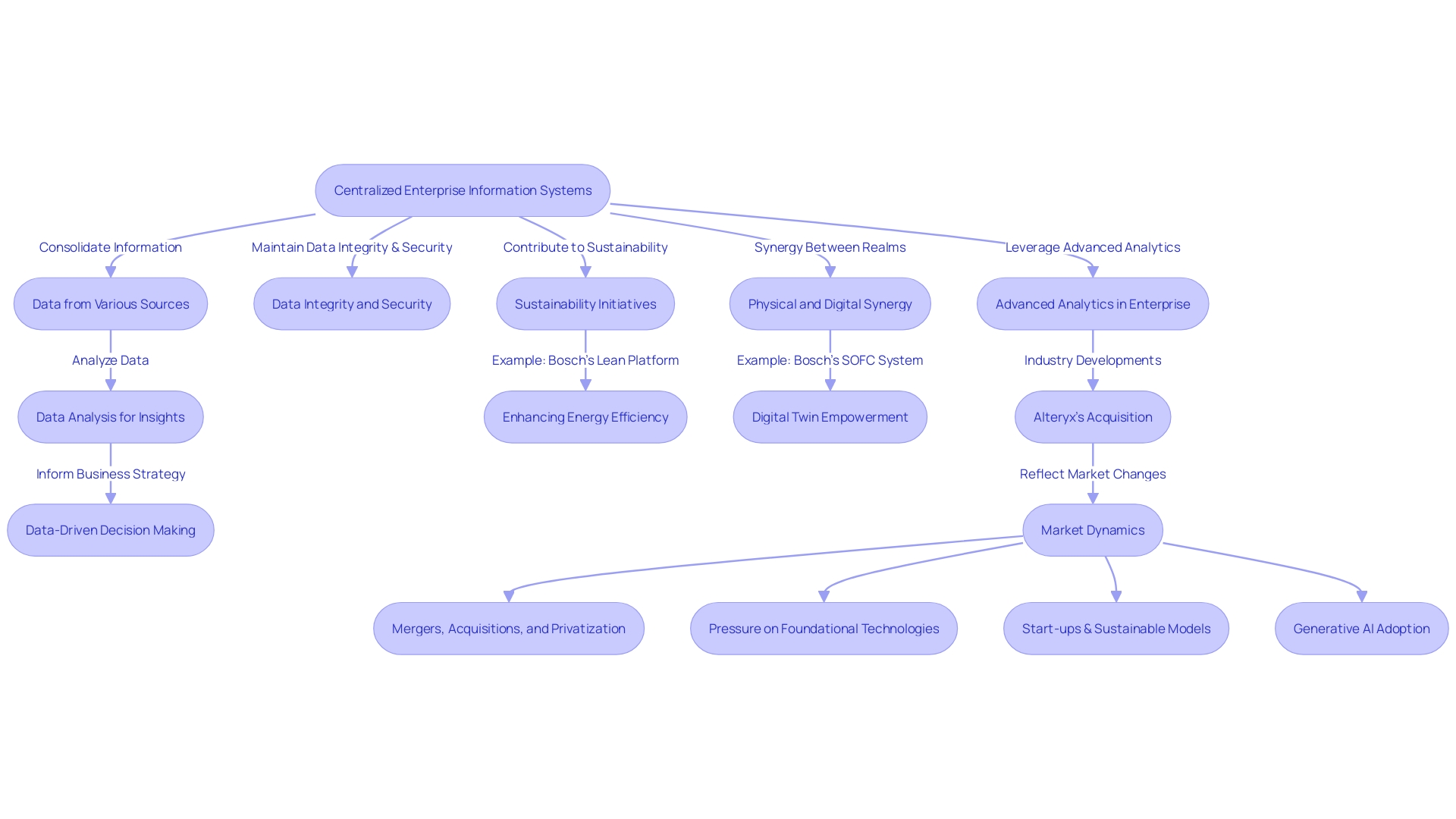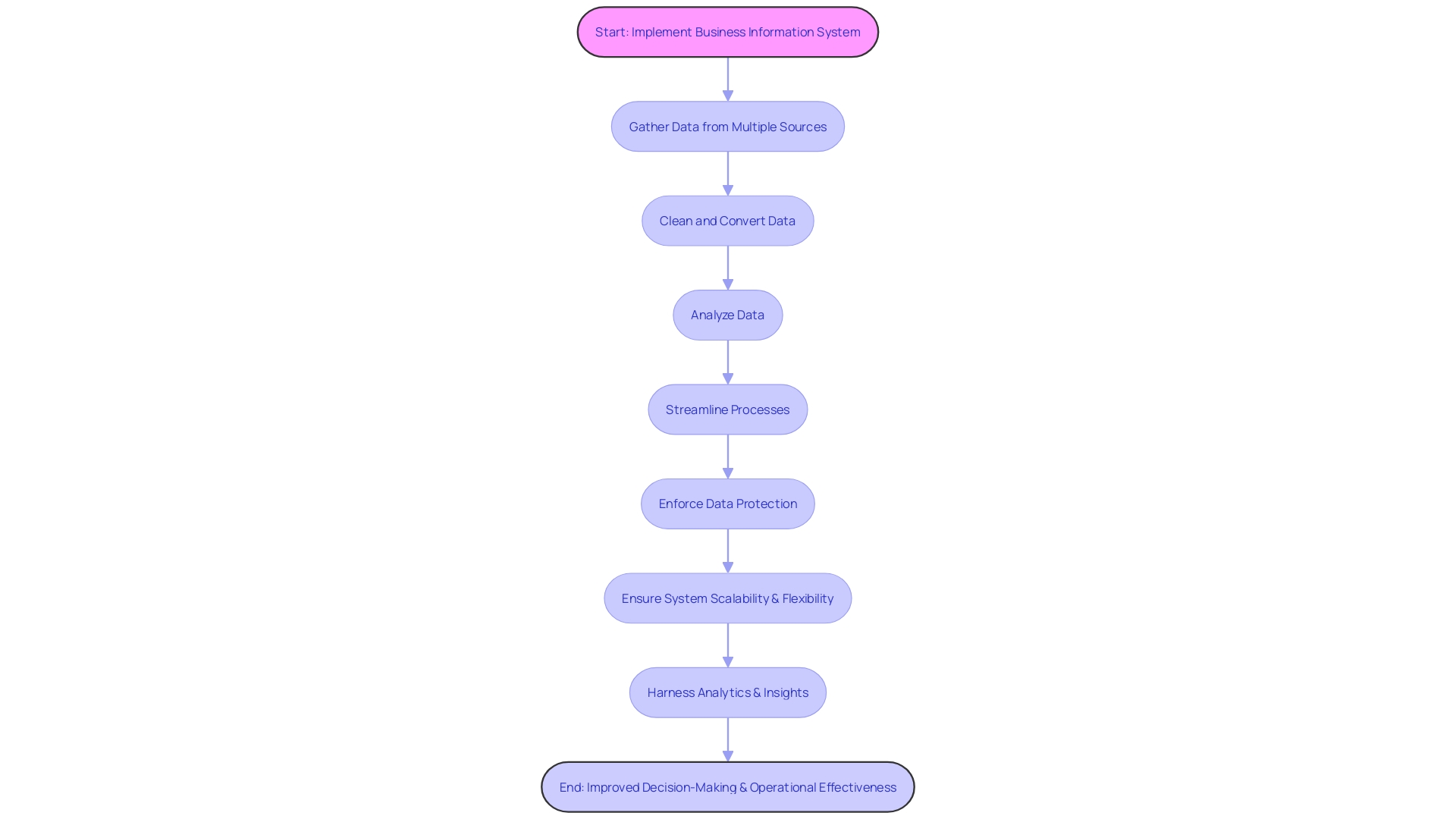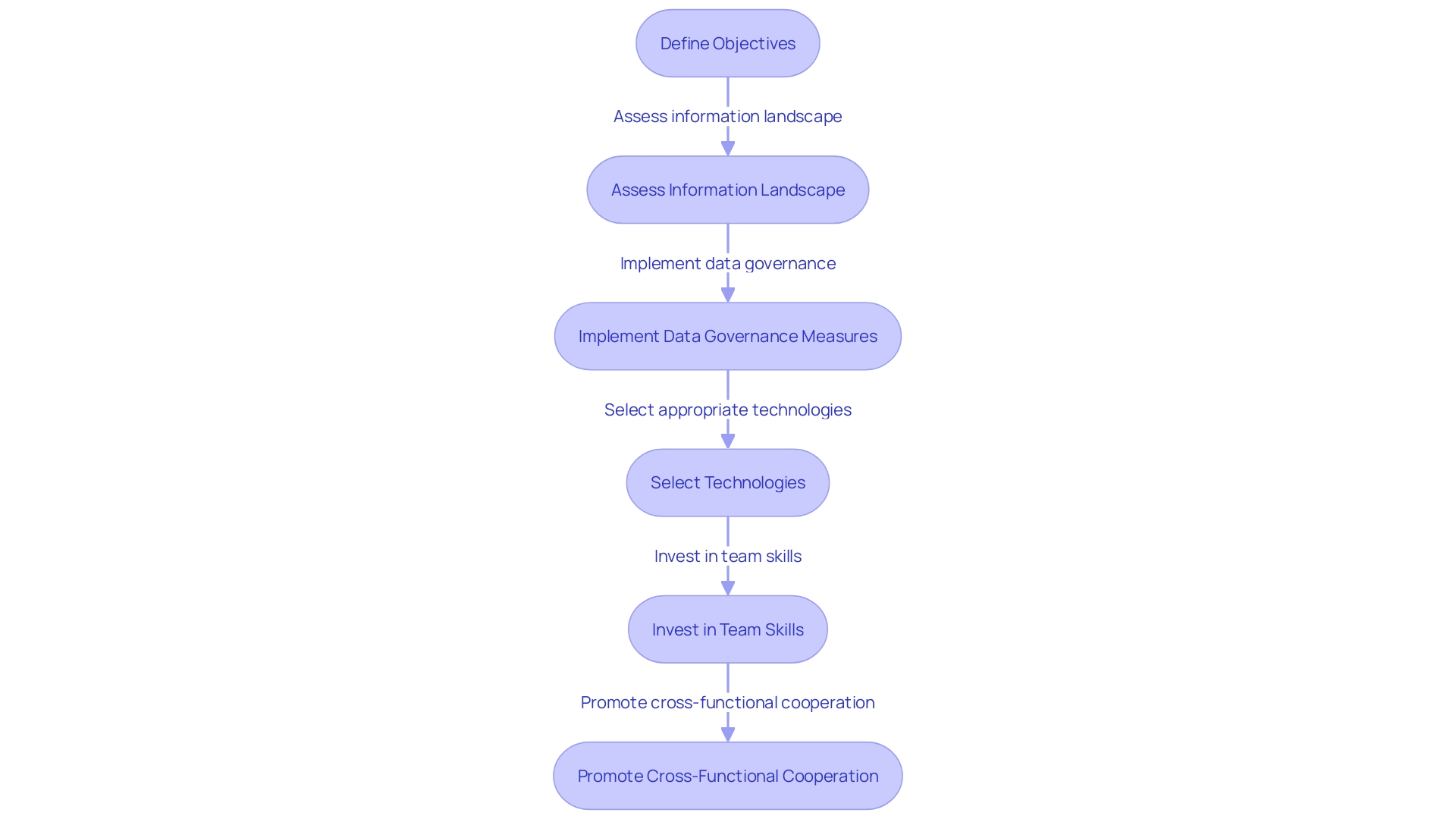Introduction
Centralized enterprise data platforms serve as the backbone for organizations seeking to harness the power of data-driven decision-making. By aggregating data from multiple sources, these platforms provide a comprehensive view, fostering a data-centric approach to business strategy. They not only facilitate data management and analysis but also play a crucial role in maintaining data integrity and security.
In this article, we will explore the key components of an enterprise data platform, the importance of data governance and quality management, the challenges in implementing such a platform, and the strategies for building an effective one. We will also discuss the benefits of adopting an enterprise data platform and the future trends and considerations in this evolving field. Whether you are a business leader or a data professional, this article will provide valuable insights into the world of enterprise data platforms and their significance in driving organizational success.
What is an Enterprise Data Platform?
Centralized enterprise information systems serve as the foundation for organizations seeking to leverage the potential of data-driven decision-making. By consolidating information from various sources, these systems offer a holistic perspective, promoting a data-focused approach to business strategy. They not only support the management and analysis but also play a crucial role in maintaining integrity and security. For instance, Bosch's implementation of a lean, evolutionary platform supports its sustainability initiatives, showcasing how deep engineering expertise can be applied to enhance energy efficiency and promote greener energy solutions. Bosch's solid oxide fuel cell (SOFC) system, empowered by a digital twin, exemplifies the synergy between physical and digital realms, enabling real-time monitoring and optimization throughout the system's lifecycle. Furthermore, recent industry developments, like Alteryx's acquisition by Clearlake and Insight Partners for $4.4 billion, indicate the increasing significance of advanced analytics in the enterprise sector. As businesses navigate the intricacies of governance and compliance, ensuring the quality of information becomes paramount. This includes establishing quality standards and monitoring information quality scores to support informed decision-making. The evolving technology landscape necessitates that organizations prioritize these considerations to stay competitive and resilient against emerging challenges.

Key Components of an Enterprise Data Platform
A complex system has been created to enable sophisticated management and analysis of information. At its core, the platform comprises several integral components:
-
Storage is the basis for a strong enterprise platform with extensive storage capabilities. It must skillfully handle vast quantities of both structured and unstructured information while ensuring information integrity and offering scalability. Industry leaders often rely on a combination of relational databases, expansive lakes, and versatile cloud-based storage solutions to meet these needs.
-
The crucial element of merging various sources of information into a unified entity is the foundation of information integration. This procedure typically involves extracting information from diverse systems, standardizing it to a common format, and then loading it into the platform. Such smooth integration is vital for preserving consistency and upholding accuracy across the enterprise.
-
Governance and Quality Management: Governance encompasses the various procedures, policies, and controls that safeguard privacy, uphold security measures, and ensure compliance with relevant regulations. Enhancing governance is the management of information quality, which emphasizes the ongoing enhancement of the precision, entirety, and dependability of data. Collectively, they form an essential element for fostering trust and reliability in the information of the system.
-
To interpret intricate information into actionable observations, an enterprise information system should be equipped with robust analytics and visualization tools. Users can benefit from these capabilities to interpret information and present findings in a clear, engaging manner. The incorporation of advanced analytics, utilizing machine learning and artificial intelligence, further empowers the system to uncover concealed patterns, recognize trends, and anticipate future outcomes.
Adapting to the evolving technological landscape, companies like Bosch have employed these components to address pressing global issues such as sustainability. By harnessing a combination of physical and digital engineering, Bosch has innovated in green energy production through solutions like the solid oxide fuel cell (SOFC) system. The SOFC not only achieves high electrical efficiency but also incorporates a digital twin for real-time visualization and monitoring, thus optimizing both cost and performance throughout its lifecycle.
Aligned with the most recent advancements, the purchase of Alteryx by Clearlake and Insight Partners for $4.4 billion highlights the importance of advanced platforms in the analytics and science realm. Moreover, the anticipation of the Global Database Management Systems (DBMS) Market's evolution by 2030 highlights the crucial role these systems play in strategic decision-making and identifying new business opportunities.

The Importance of Data Governance and Quality Management
Ensuring information accuracy and adherence is crucial in today's technology-driven landscape. Governance goes beyond simple management by establishing a strategic framework that ensures availability, integrity, security, and value. This is an essential element within enterprise architecture, crucial for effective science, business intelligence, and AI initiatives. A clearly defined governance strategy involves establishing guidelines and principles for the utilization and handling of information, thereby enhancing the organization and management of resources.
Stewardship plays a crucial role by delineating clear ownership and accountability, which is essential for maintaining quality and adhering to stringent regulatory demands. For example, M&T Bank, with its longstanding dedication to innovation and community-focused banking, has taken on the challenge of implementing Clean Code standards to strengthen software maintainability and performance, reflecting governance's role in ensuring operational resilience and security in the digital transformation era.
Likewise, Bosch's commitment to sustainability and green energy production is supported by streamlined, progressive information platforms that promote effective governance practices. These practices are not just about establishing control but also about fostering an environment where information can be a driver for decision-making and innovation.
The importance of governance is further emphasized by the metrics that influence its effectiveness. As an instance, the Mean Time to Resolution (MTTR) for incidents related to information, which demonstrates the agility of a company in handling issues related to information, and the Mean Time to Production (MTTP), which gauges the pace at which new information products are introduced to the market, are crucial indicators of a strong information governance framework. According to Forbes, scientists specializing in information spend roughly 80% of their time on preparation, underscoring the significance of quality control in minimizing the time it takes to bring data-based products and insights to market.
Ultimately, a thorough governance and quality management system is not solely focused on reducing risks; it involves fostering a culture centered around information that drives enterprises towards attaining their strategic goals in a progressively information-dependent society.
Data Storage and Accessibility
The transformation of business information systems, with their expandable and protected storage mechanisms, has become a game-changer for organizations struggling with growing amounts of information. A carefully designed system can handle both organized and disorganized information, assisting a wide range of formats. Accessibility is a foundation of these platforms, ensuring that authorized personnel can swiftly retrieve and manipulate information. This requirement has resulted in the implementation of advanced measures like role-based access controls, encryption, and information masking to protect sensitive information.
In practice, companies like Azur Games have confronted the need to modernize their technical infrastructure to manage immense databases, like their 120 TB ClickHouse, without downtime. Similarly, a U.S. defense agency transformed its storage infrastructure to reduce its center footprint by 25%, enhancing resilience and achieving cost savings — exemplifying how strategic storage solutions can align with broader organizational and environmental goals.
The promise of innovation in storage and management is further illustrated by initiatives like Project Silica, which explores storing information in quartz glass, and the emergence of tools that transform storage into a strategic element for high-end processing. These advancements highlight the significance of information remaining in place, accessible without unnecessary duplication or complex management systems.
Organizations are acknowledging the crucial role information plays in powering AI technology, with AI servers boasting significantly larger capacities to handle the requirements. The insights from information are now seen as a competitive edge, integral to leveraging AI for business objectives. Therefore, the choices made in infrastructure today will profoundly influence future capabilities.
In the midst of this landscape, the market for information continues to skyrocket, with an estimated $77 billion in revenue in 2023 and projections of reaching $401.2 billion by 2028. The staggering volume of information generated by internet users, which stands at about 1.7 megabytes per second per user, reflects the immense scale and velocity of the big data phenomenon. Nevertheless, with this expansion comes the challenge of safeguarding information, a concern expressed by IT professionals who observe a growing gap between information growth and security capabilities.
The Role of Data Integration and Analytics
The enterprise information landscape is constantly changing, and within this dynamic environment, integration and analytics serve as the twin pillars of a strong information strategy. The necessity to incorporate information arises from the requirement to dissolve silos that historically fragmented knowledge across various departments. Modern integration techniques involve more than just the traditional Extract, Transform, Load (ETL) processes; they are about creating ecosystems where information from diverse sources and formats can be harmonized, ensuring consistency and accuracy.
Advanced analytics, utilizing techniques like information mining, machine learning, and predictive modeling, then interprets this unified information to reveal patterns, trends, and correlations. These insights are not mere numbers but are the lifeblood of strategic business decisions that can propel growth and foster innovation.
Drawing inspiration from industry pioneers such as Bosch, who have utilized their expertise in both physical and digital engineering to develop an efficient and progressive platform for green energy, companies are recognizing the potential of integrating operational and analytic information systems. Bosch's solid oxide fuel cell (SOFC) system, backed by a digital twin, exemplifies the synergy of integration and analytics, optimizing performance and cost over the system's lifecycle.
However, the journey towards seamless information integration is not without its challenges. As illustrated by the U.S. Bureau of Economic Analysis, the digital economy encompasses diverse domains like ICT infrastructure, e-commerce, and priced digital services. Similarly, enterprises must navigate through a range of information types and sources. Integration tools can serve as a panacea to the costly issue of inaccurate information, which, according to The National Law Review, costs U.S. companies over 3 trillion dollars annually. These tools not only mitigate human error but also provide a reliable foundation for analytics to thrive on.
By embracing the advancement of information integration and analytics, companies can strive for a future where evidence-based decision-making is the standard, resulting in a competitive advantage in an increasingly information-focused market.
Benefits of an Enterprise Data Platform
Embracing a business information system is crucial in updating the operational framework of a company, offering vital functionalities for improved decision-making and operational effectiveness. Here's how:
-
Informed Decision-Making: Data is the lifeblood of informed decision-making. An enterprise information system brings together information from different sources, providing a unified, precise, and up-to-date picture. This empowers organizations to make decisions with precision, akin to Bosch's implementation of the solid oxide fuel cell system, which integrates a digital twin for monitoring key process parameters.
-
Operational Efficiency: Efficiency is not merely about speed; it's about simplifying processes. A centralized information system streamlines integration and reduces duplication. This reflects the development of thinking regarding systems over the past five years, concentrating on operational efficiency by removing unnecessary manual procedures in preference for automated solutions.
-
In the age of cyber threats, a robust data protection system acts as a stronghold, enforcing stringent security measures to safeguard sensitive information. This is crucial, as adherence and protection against cyber threats form the core of information governance—essential for privacy, security, and safeguarding.
-
Scalability and Flexibility: A platform that scales with your organization's growth is a cornerstone for future success. The ability to incorporate new sources of information and adjust to changing business requirements is demonstrated by Bosch's scalable SOFC systems, designed to meet growing demands for green energy.
-
Harnessing analytics and insights leads to a competitive edge by identifying trends, customer preferences, and opportunities. As Clarke's adage goes, advanced technology seems magical, but it's the strategic application of insights that creates real magic in the marketplace.
Furthermore, the quality and governance of information are prerequisites for these benefits. In line with industry best practices, establishing quality benchmarks and monitoring scores are essential, as suggested by recent findings on flourishing platform enterprises. Furthermore, addressing the constraints of outdated systems, like challenges in monitoring and upholding information accuracy, is crucial for a future-proof strategy.
Ultimately, the aim is to synchronize technology with organizational objectives, ensuring that every investment in information infrastructure contributes to the overarching vision of efficiency, security, and innovation.

Challenges in Implementing an Enterprise Data Platform
Implementing an enterprise platform can greatly improve an organization's ability to utilize its information, yet the process of integration is characterized by a series of difficult obstacles. Among these, the complexity of information sourced from a multitude of origins, existing in diverse formats, and demonstrating variable quality stands as a primary concern. The task of integrating this diverse information demands a strong plan and advanced tools.
Focus on governance and compliance is another critical aspect that requires meticulous planning and execution, as regulatory demands can be intricate and burdensome. Managing this complexity is not merely a matter of policy but requires a thorough understanding of the regulatory landscape.
The shift towards a data-centric platform is not solely a technological venture but also a cultural one, necessitating a change in organizational mindset and operations. This transformation often encounters resistance as it disrupts established processes and alters roles within the company.
Moreover, concerns regarding security and privacy are always present, with organizations being responsible for safeguarding sensitive information from breaches while adhering to strict laws on data protection. This ongoing obligation calls for vigilant governance and state-of-the-art security measures.
Lastly, the scarcity of professionals with the necessary skills in information management and analytics is a significant hurdle. Constructing and sustaining a corporate information system necessitates a group with not only technical expertise but also a strategic perspective for capitalizing on information efficiently.
These challenges are not insurmountable, as shown by the experience of Bosch, a leader in engineering and technology that has successfully navigated the complexities of information to drive sustainability initiatives. Bosch's implementation of a solid oxide fuel cell system, accompanied by a digital twin, showcases the capability of advanced information systems to enhance efficiency and accomplish corporate goals.
Data silos, which represent isolated pockets of information within a company, further complicate the utilization of enterprise platforms. These silos can emerge because of incompatible formats and standards across different applications, resulting in inaccessible and underutilized information. Overcoming these barriers is crucial for unleashing the complete potential of an entity's information assets.
To sum up, although the advantages of a business information system are numerous, the journey to its effective execution is filled with obstacles that require a strategic method involving technology, governance, and culture. By addressing these obstacles with foresight and expertise, organizations can harness the immense potential of their information and drive innovation and efficiency across their operations.

Strategies for Building an Effective Enterprise Data Platform
Developing a business information system is a complex undertaking, necessitating a strategic method to guarantee harmony with corporate goals and a smooth assimilation into current workflows. When forming the foundation for such a critical system, it’s essential to start with well-defined objectives. The objectives of your information system must align with your business's overarching approaches, guaranteeing that every piece of information has the potential to enlighten and impact critical business determinations.
Comprehending your information landscape is next, which entails a thorough assessment of information sources, formats, and quality. This step is crucial for identifying the right technology stack required to build a robust platform. As we look to industry leaders like Bosch and their implementation of digital twins in their solid oxide fuel cell systems, we see the importance of digital infrastructure that not only supports current needs but also scales with evolving demands.
Data governance cannot be an afterthought. Implementing rigorous measures and designating dedicated stewards guarantees the integrity, privacy, and security of your information. This aligns with the growing concern for information security in our increasingly digital world, as noted in recent white papers, and is paramount for maintaining trust and compliance.
Selecting the right technologies is a balancing act between current capabilities and future growth. By opting for scalable solutions, such as cloud-based systems, you prepare your organization for future information expansion. This foresight is backed by the understanding that the digital divide is not a mere inconvenience but a significant barrier to technological advancement for many regions, as highlighted by the exceptions in global digital service coverage.
Investing in your team's skills is just as important as the technologies you deploy. Training in information management and analytics ensures that your personnel are equipped to handle the sophisticated tools and systems that drive insights.
Finally, promoting cross-functional cooperation bridges the gap between IT and business units, ensuring a cohesive strategy for information utilization. The progression of corporate technology, characterized by the emergence of AI, big data analytics, and cloud computing, requires a cohesive strategy to navigate the intricacies of the contemporary information overload and unleash the complete potential of your company's information infrastructure.

Future Trends and Considerations
Contemporary business systems are flexible, constantly adapting to fulfill the requirements of a technology-driven corporate setting. These systems are pivotal in leveraging the potential of information and AI to generate practical observations and propel business advancement. Here are some key trends shaping the future of data platforms:
-
Artificial Intelligence (AI) and Machine Learning (ML) Integration: AI and ML are becoming essential to systems, automating processes, enhancing analytics, and revealing crucial insights. For example, AI can assist in various industries, from automating customer service chatbots to enabling predictive analytics in healthcare. Generative AI is particularly influential, with significant adoption in marketing, sales, and product development.
-
Cloud-Based Data Management: The adoption of cloud solutions is on the rise due to their scalability, flexibility, and cost-efficiency. Cloud-based solutions are evidence of this pattern, as they can greatly decrease expenses related to infrastructure. Companies like Bosch are utilizing these solutions to build lean, evolutionary platforms that support sustainable and efficient energy production.
-
Information Security and Privacy: With strict regulations on privacy in place, organizations are giving priority to the security and compliance of their information. This includes strong security measures to protect integrity and privacy, as Bosch has exemplified in its commitment to responsible governance.
-
Real-Time Analytics: The ability to analyze streaming information in real-time is crucial for quick decision-making and agility in response to market dynamics. This trend is underscored by the demand for on-premises solutions like CloudCasa that offer real-time backup and recovery capabilities.
-
There is a movement towards making information more accessible across organizations, empowering business users to independently analyze and utilize it. This promotes a culture of well-informed decision-making and aligns with the principles of democratization of information.
-
Ethical Use of Information and Governance: As information collection and analysis scale, ethical considerations become paramount. Responsible governance and adherence to ethical guidelines are essential, as seen in companies like BMW Group, where experts like Amor Steinberg ensure technological innovation is balanced with compliance and security.
Incorporating these key components into a modern data platform strategy will enable organizations to address the challenges and opportunities of a data-centric business landscape effectively.
Conclusion
In conclusion, a centralized enterprise data platform is crucial for organizations to harness the power of data-driven decision-making. It aggregates data from multiple sources, fostering a data-centric approach to business strategy. The key components include data storage, integration, governance, and analytics, ensuring data availability, integrity, security, and value.
Data governance and quality management are essential in today's technology-driven landscape. They establish a strategic framework for data integrity, security, and compliance. Robust data governance practices foster an environment where data can drive decision-making and innovation.
The evolution of enterprise data platforms revolutionizes data storage and accessibility. They accommodate vast amounts of structured and unstructured data, ensuring scalability and security. Organizations must recognize the vital role data plays in fueling AI technology and make infrastructure choices that align with future capabilities.
Data integration and analytics are the twin pillars of a robust data strategy. Integration dissolves data silos and ensures consistency, while analytics reveals patterns and trends. By integrating operational and analytic data systems, organizations optimize performance and achieve business objectives.
Adopting an enterprise data platform provides benefits such as informed decision-making, operational efficiency, robust data security, scalability, and a competitive advantage. Data quality and governance are prerequisites for these benefits. Organizations must set quality standards and track data scores to ensure success.
Building an effective enterprise data platform requires a strategic approach, including well-defined objectives, understanding the data landscape, robust governance, selecting scalable technologies, investing in skills, and fostering collaboration.
Looking towards the future, data platforms will continue to evolve, incorporating trends such as AI integration, cloud-based data management, data security and privacy, real-time analytics, data democratization, and ethical data use. By incorporating these trends into their strategies, organizations can navigate the challenges and opportunities of a data-centric business landscape.
In summary, adopting an enterprise data platform is pivotal for modernizing organizations, enhancing decision-making, and driving efficiency. By addressing challenges, leveraging key components, and considering future trends, organizations can unlock the full potential of their data and thrive in a data-driven world.




